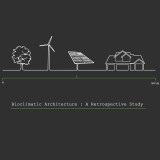The first indications of bioclimatic architecture, first appeared in Ancient Greece. The need to exploit solar energy arose from a lack of raw materials, led to alternative ways of building. The use of solar heating, as well as the need for proper orientation, did not spread everywhere in the same way, due to social or economic conditions. Even though, the industrial revolution subsequentlyled bioclimatic architecture to a downturn, its evolution never ceased. Over the years, bioclimatic architecture became more significant, as the depletion of fossil fuels has begun to make the need of exploitation of natural resources a necessity in every way possible. Now, energy planning is an important parameter for architecture, both technically and environmentally. The consideration about the environmental preservation has led to measures, in order to ensure the best possible techniques concerning the building configuration, with the lowest energy efficiency possible. The European Union, by providing guidelines, urges European countries to transform their buildings into net-zero energy, setting limits for the immediate future. In the early 20th century, bioclimatic architecture was a way of life in many areas in Greece, such as Pelion, where traditional houses have been an important reference point for bioclimatic buildings. Nowadays, although things are slowly evolving, there are building examples to imitate across the country, which makes the future of bioclimatic architecture seem particularly promising.
